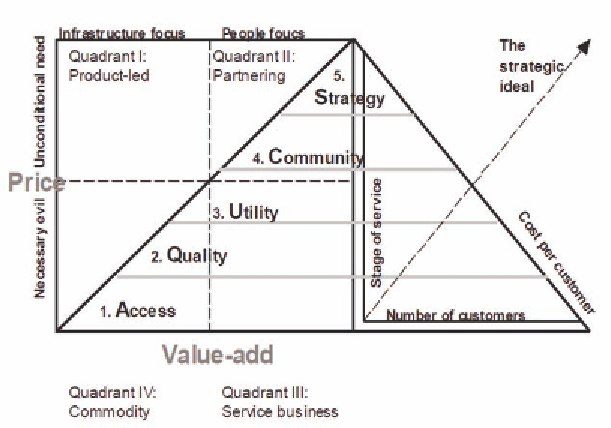Information Technology Reference
In-Depth Information
Figure 5. Goldstuck's model of Internet industry structure (Source Goldstuck (2007 83))
LIGHT AT THE END OF A
DARK (UNLIT) TUNNEL
x axis indicates increasing price levels and the
y-axis represents increasing value-added services
on offer. These are categorised as product-led
(the ISP attempts to cater for business strategic
business needs through an extensive product suite
of products), partnering (the ISP focuses on part-
nering with a client in order to meet its needs),
service (the ISP provides basic strategic needs) and
commodity (the ISP provides core access needs).
On the right-hand side of the triangle, the
impact of these business models on the revenue
streams of the ISP is demonstrated. Typically, an
ISP operating in the access arena (i.e. a commodity
business) will possess a large amount of clients,
but relatively low average revenue per client. An
ISP operating in the strategic arena (i.e. tailoring
offerings as per client expectations) may have
fewer clients of a higher average revenue each.
The strategic ideal is to migrate clients to as high
a level as possible.
Reducing the cost structure of broadband con-
nectivity is an imperative. However, the cost
components in offering a broadband service are
somewhat complex. Admin related expenses such
as technical support, billing and general back of-
fice functions need to be catered for. Technical
expenses such as local bandwidth provisioning,
international bandwidth provisioning, network
fault resolution and even the construction of a
'last mile' access network (connecting end users
to the network backbone) are highly pertinent to
end user pricing. The latter areas, in particular,
have spent much time in the media spotlight of
late. This is surmised to be an area wherein im-
provements are likely to have a material effect
on reducing broadband pricing in South Africa.
Until recently, most ISPs were dependent on
a small group of national carriers such as Telkom
to relay their traffic between cities. Somewhat
surprisingly, a sector of national (local) bandwidth
may be more expensive than a sector of interna-
tional bandwidth. To this end, ISPs have reported

Search WWH ::

Custom Search